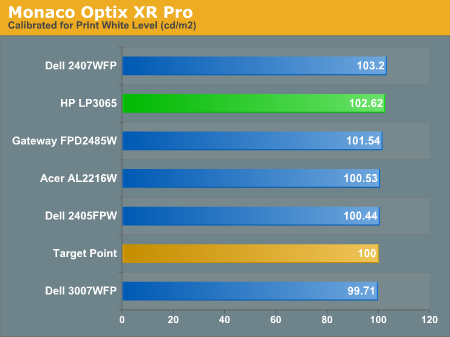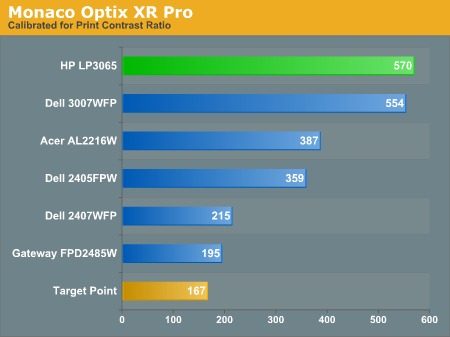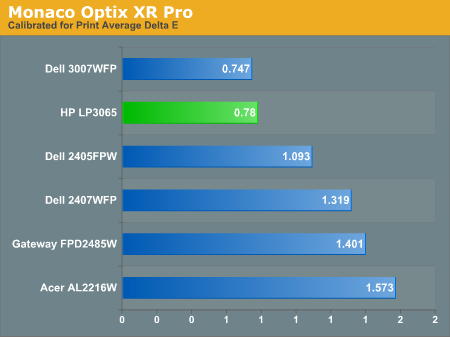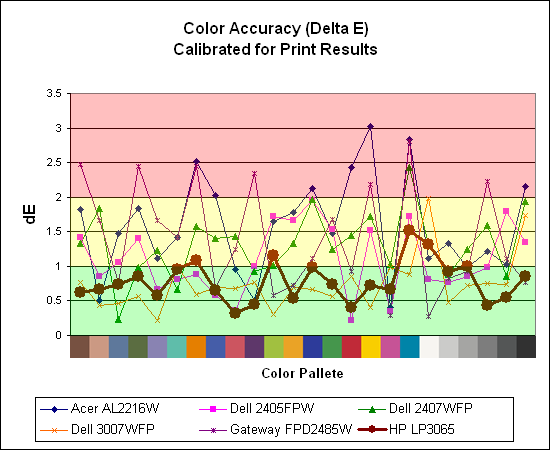HP LP3065: A new contender for the 30" throne
by Jarred Walton on March 22, 2007 7:00 AM EST- Posted in
- Displays
Printing Results
Brightness and Contrast Ratio
Using the standard calibration procedures works well if you only plan on using your computer with online data. In fact, you can generally set whatever brightness and contrast levels you want and then let the calibration software adjust the color profile as appropriate (although depending on the display certain settings will produce more or less accurate colors). However, many image professionals also have a need to match colors between their computer displays and their cameras and printers, and what works well for computing purposes often isn't the best suited for doing other image related work. To help people who work in such areas match their computer colors to their paper colors better, some standards were established. Generally speaking for print work the standard is a gamma of 2.2 (some people recommend 1.8, but we'll use 2.2), a black point of 0.60 cd/m2, and a white point of 100 cd/m2.
Finding the appropriate settings to reach these levels can be a time-consuming process. Numerous iterations through the calibration process are required in order to end up with the desired white point, and on some LCDs it might not even be possible to reach a satisfactory result. We were unable to get both an accurate white point and an accurate black point according to printing requirements (our black levels always ended up darker than they were supposed to be) but eventually we did manage to get near the desired 100 cd/m2 white point on all of the tested displays. This required adjusting the individual color levels on most of the displays, but the Dell 3007WFP and HP LP3065 lack this option so we simply reduced the brightness levels. Here are the settings we ended up using:
Dropping just the brightness on the Gateway FPD2485W and Dell 2407WFP did not reach the required white point, in the case of the former not by a long shot. We also found that dropping the brightness level to zero and then further reducing the color levels did not generate desirable results. We were most successful when we set the color levels to a moderate value and then tweaked the brightness and color levels as necessary to get the desired result. Here's how the brightness and contrast ratios changed with these tweaks.



We were not attempting to get 100% accuracy on the white point, but further tuning of the various displays would have likely made it possible to get closer to 100 cd/m2. The primary goal was to merely get the white point down to near 100 cd/m2 if possible. The target black point on the other hand is much more difficult to achieve once we have reached the target white point. Due to the reduced brightness level, contrast ratios are lower, but that is expected with print material. For reference, we have included the target values in the above graphs, so the greater the deviance of the display from the targeted value, the less suitable a display becomes for print work. Having calibrated the displays for printing, let's see how they actually fare.
Color Accuracy
Given the importance of accurate colors for printing work, we have adjusted the Delta E scale appropriately. A Delta E of less than 1.0 is definitely the goal here, and 1.0 to 2.0 is merely acceptable. Scores above 2.0 basically mean that the display is not fit for printing professionals.


The 30" displays definitely come into their own in this particular test, not only because they are far easier to calibrate (you just turn down the brightness level) but also because they score very well. The Dell 3007WFP and HP LP3065 are clearly the best displays for printing work, with very low average Delta E scores. In fact, the worst Delta E that the HP registers is only 1.52, and only five of the tested colors have a Delta E of 1.0 or more. Whether it's the overall quality of the displays or simply the S-IPS panels on the 30" LCDs, the fact is that these displays appear to be targeted more at professionals than any of the others. Considering the cost, that's probably not too surprising.
Brightness and Contrast Ratio
Using the standard calibration procedures works well if you only plan on using your computer with online data. In fact, you can generally set whatever brightness and contrast levels you want and then let the calibration software adjust the color profile as appropriate (although depending on the display certain settings will produce more or less accurate colors). However, many image professionals also have a need to match colors between their computer displays and their cameras and printers, and what works well for computing purposes often isn't the best suited for doing other image related work. To help people who work in such areas match their computer colors to their paper colors better, some standards were established. Generally speaking for print work the standard is a gamma of 2.2 (some people recommend 1.8, but we'll use 2.2), a black point of 0.60 cd/m2, and a white point of 100 cd/m2.
Finding the appropriate settings to reach these levels can be a time-consuming process. Numerous iterations through the calibration process are required in order to end up with the desired white point, and on some LCDs it might not even be possible to reach a satisfactory result. We were unable to get both an accurate white point and an accurate black point according to printing requirements (our black levels always ended up darker than they were supposed to be) but eventually we did manage to get near the desired 100 cd/m2 white point on all of the tested displays. This required adjusting the individual color levels on most of the displays, but the Dell 3007WFP and HP LP3065 lack this option so we simply reduced the brightness levels. Here are the settings we ended up using:
| Calibrated for Print Settings Gamma 2.2, White 100 cd/m2, Black 0.60 cd/m2 |
||||||
| Acer AL2216W | Dell 2405FPW | Dell 2407WFP | Dell 3007WFP | Gateway FPD2485W | HP LP3065 | |
| Brightness | 80 | 50 | 100 | 25 | 100 | 91 |
| Contrast | 80 | N/A | N/A | N/A | 100 | N/A |
| Red | 40 | 7 | 49 | N/A | 32 | N/A |
| Green | 39 | 10 | 50 | N/A | 32 | N/A |
| Blue | 39 | 11 | 46 | N/A | 32 | N/A |
Dropping just the brightness on the Gateway FPD2485W and Dell 2407WFP did not reach the required white point, in the case of the former not by a long shot. We also found that dropping the brightness level to zero and then further reducing the color levels did not generate desirable results. We were most successful when we set the color levels to a moderate value and then tweaked the brightness and color levels as necessary to get the desired result. Here's how the brightness and contrast ratios changed with these tweaks.



We were not attempting to get 100% accuracy on the white point, but further tuning of the various displays would have likely made it possible to get closer to 100 cd/m2. The primary goal was to merely get the white point down to near 100 cd/m2 if possible. The target black point on the other hand is much more difficult to achieve once we have reached the target white point. Due to the reduced brightness level, contrast ratios are lower, but that is expected with print material. For reference, we have included the target values in the above graphs, so the greater the deviance of the display from the targeted value, the less suitable a display becomes for print work. Having calibrated the displays for printing, let's see how they actually fare.
Color Accuracy
Given the importance of accurate colors for printing work, we have adjusted the Delta E scale appropriately. A Delta E of less than 1.0 is definitely the goal here, and 1.0 to 2.0 is merely acceptable. Scores above 2.0 basically mean that the display is not fit for printing professionals.


The 30" displays definitely come into their own in this particular test, not only because they are far easier to calibrate (you just turn down the brightness level) but also because they score very well. The Dell 3007WFP and HP LP3065 are clearly the best displays for printing work, with very low average Delta E scores. In fact, the worst Delta E that the HP registers is only 1.52, and only five of the tested colors have a Delta E of 1.0 or more. Whether it's the overall quality of the displays or simply the S-IPS panels on the 30" LCDs, the fact is that these displays appear to be targeted more at professionals than any of the others. Considering the cost, that's probably not too surprising.










44 Comments
View All Comments
Renoir - Friday, March 23, 2007 - link
That sounds like a very reasonable assumptionStill looking around for confirmation but I thought the ICT only affected analogue connections. If it does indeed affect digital connections then why are current software players not allowing full res over non HDCP compliant dvi ports given that no current discs have ICT enabled? We should be able to answer most of these questions when you get that laptop. I very much look forward to the review.
JarredWalton - Friday, March 23, 2007 - link
Bad news... the laptop is single-link. :(I'll still be able to test HDCP on a non-HDCP display, though. I've got a 2405FPW so we'll see what happens. Could be the software companies enforcing something that isn't strictly required?
chakarov - Friday, March 23, 2007 - link
Hope this could help you:http://www.behardware.com/articles/656-1/hdcp-prot...">http://www.behardware.com/articles/656-...ion-is-n...
Renoir - Sunday, March 25, 2007 - link
That link seems to confirm what I said which is that the ICT only applies to analogue connections and HDCP is always required for full res over a digital connection. At first Jarred I thought you might be right in that the software companies may be implementing something that isn't strictly required but the article linked shows that standalone units operate in the same way suggesting that that's the way it's supposed to work.chakarov - Friday, March 23, 2007 - link
In the specs:http://h10010.www1.hp.com/wwpc/us/en/sm/WF06a/3820...">http://h10010.www1.hp.com/wwpc/us/en/sm...382087-6...
And even in the detail specs:
http://h18000.www1.hp.com/products/quickspecs/1262...">http://h18000.www1.hp.com/products/quickspecs/1262...
There is no mentioning of HDCP support.
There is nothing officially written.
May be there is a reason?
JarredWalton - Friday, March 23, 2007 - link
Interesting... I'm sure I saw HDCP there when I was working on the review, and I can find numerous web links where it says HDCP is supported (at single-link resolutions). I wonder if they updated the page recently to remove HDCP?Renoir - Friday, March 23, 2007 - link
Well the review states HDCP support and Loyd over at extremetech said that he was told by HP that the display "offers HDCP at full dual-link bandwidth". This information is what I'm basing my questions on although the fact that HDCP isn't mentioned in your links merely confirms that the situation is clear as mud. Clearly someone is either misinformed or spec sheets have been poorly writtenmi1stormilst - Thursday, March 22, 2007 - link
I have delt with a number of companies when trying to help friends and family with store bought PC's and there is no question that HP is second to none with tech support. If you own a HP system use the online chat support...it is excellent.leousb - Thursday, March 22, 2007 - link
To buy a monitor this huge just for gaming is IMHO a complete obscenity.OrSin - Thursday, March 22, 2007 - link
People been saying the asme thing about BMW, 65" tvs and pretty (but dumb) women.In the words of bart "We do what we like"